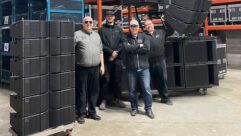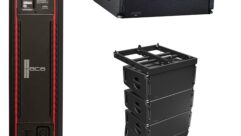A look at line arrays
Mar 1, 2000 12:00 PM,
Glenn Leembruggen
The directional behavior of line arrays is due to three main factors. Thefirst is the relative differences in the path length from a point in spaceto each drive unit. The second factor is the amplitude and phase shift ofthe signal applied to one drive unit compared to the others. The third isthe directivity of the individual drive units.
In a line array, the sound on the main axis of radiation results fromconstructive interference between all the drive units, while the off-axisbehavior is the result of partially constructive or destructive behavior.On the main axis of the array, SPL increases by 6 dB for each time thenumber of drive units in the array doubles. This is because the path lengthfrom each drive unit to the listener is essentially the same, causing equalphase shift to each driver and allowing constructive addition of the soundpressures of all drive units.
Off axis, the path length to each drive unit is different, causing phasedifferences between each drive unit’s acoustic signal and resulting inpartial cancellation or destructive interference. The longer the array, themore off-axis destructive interference occurs and the more directional itis at lower frequencies.
The main problem with line arrays is that they exhibit strong lobingeffects at off-axis angles when the array becomes acoustically long. Thisis due to the path length to some or all drivers becoming close tomultiples of 360 degree (one or more full cycles) and occurs at thosefrequencies at which the separation of the drive units is more than onequarter of a wavelength. Constructive addition then results at thisoff-axis location and the off-axis attenuation at lower frequenciessuddenly turns into a boost at higher frequencies.
Lobing can be prevented using a combination of three techniques. The firstis to make the array’s acoustical length constant with frequency byacoustically shortening the array as the frequency rises. Acousticalshortening is achieved by using low-pass filters to roll off the signal fedto the outermost drivers, followed by filters progressively rolling off allbut the innermost drivers. This type of array is called an electricallytapered array. The second is to make the spacing between drivers operatingat these frequencies less than 0.25 wavelengths. The third is to adjust therelative broadband level of each drive unit.
Another advantage of electrically tapered arrays is their ability togenerate much higher sound pressure levels (SPLs) at lower frequencies,which requires high piston area and high drive-unit excursion. In addition,sound systems are also usually required to deliver much more SPL at lowerfrequencies than at higher frequencies. In electrically tapered arrays, allunits share the output at low frequencies, resulting in the effectivepiston area being increased. As the frequency rises, the drive units areprogressively rolled off leaving the inner drive unit to do most of thework, but as less SPL is required at these frequencies, this is not aproblem.










